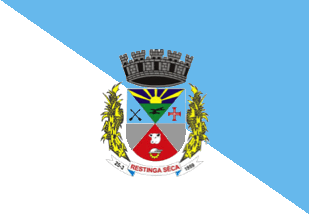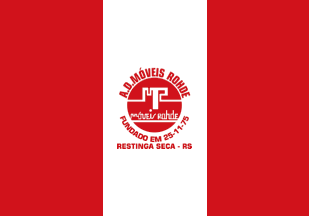 image by Ivan Sache,
3 August 2020
image by Ivan Sache,
3 August 2020
Last modified: 2020-08-08 by ian macdonald
Keywords: rio grande do sul | restinga sÍca |
Links: FOTW homepage |
search |
disclaimer and copyright |
write us |
mirrors
 image by Ivan Sache,
3 August 2020
image by Ivan Sache,
3 August 2020
The municipality of Restinga SÍca (15,849 inhabitants; 96,179 ha) is located
280 km of Porto Alegre.
Restinga SÍca was established during the building
of the railway connecting Porto Alegre to Uruguaiana. In 1885, a water tank was
built on the left bank of stream Restinga. Known as Caixa DíŃgua (Water Tank),
the place was an obligate stop for trains, where travelers and their goods had
to disembark during the water refueling of the engine. Domingos GonÁalves
Mostardeiro, a merchant of Dona Francsica required the building of a railway
station near the tank, which was inaugurated in 1898 as Rastinga SÍca station.
Elevated to the 4th district of Cachoeira do Sul in 1899, Restinga SÍca was
granted the status of "vila" on 31 March 1938. The municipality of Restinga SÍca
was established by State Law No. 3,730 promulgated on 25 March 1959.
http://www.restingaseca.rs.gov.br/
Municipal website
Ivan Sache,
3 August 2020
The flag of Restinga SÍca is prescribed by Municipal Law No. 382 promulgated
on 7 October 1977.
Article 2.
The flag has official dimensions and
white and light blue colors, diagonally separated, and is charged with the coat
of arms of the municipality.
ß1. The blue part shall be on top. The diagonal
shall run from the upper left side to the right.
https://leismunicipais.com.br/a/rs/r/restinga-seca/lei-ordinaria/1977/39/382/lei-ordinaria-n-382-1977-institui-a-bandeira-municipal
Leis Municipais database
The coat of arms of Restinga SÍca is
prescribed by Municipal Law No. 368 promulgated on 1 March 1977.
Article
1.
A shield in classical Portuguese format, gyronny in six parts, charged in
the upper right field with two crossed, stylized bone-headed arrows and in the
opposite field (left) with a Coptic cross. The arrows symbolize the Guarani
Indians led by Cacique Nicolau Nhanguiru who camped on river JacuŪ's right bank,
in a place called Passo de JacuŪ - the present-day's municipal territory - to
prevent the advance of the Portuguese troops led by Gomes Freire de Andrade,
which were stationed on JacuŪ's left bank, as represented by the red and white
Coptic cross (used by the Portuguese caravels of Pedro Ńlvares Cabral during
Brazil's discovery). The two fields are light blue, recalling the peace treaty
signed on 14 November 1754 between the Portuguese and the indigenes, which was,
probably, the first treaty signed by natives of this region to defend their
land. Blue is also a symbol of religious feelings present at the time in the
region, when both the Indians and the Portuguese "swore on the Holy Gospel" to
respect each other and, to ratify this promise, signed the aforementioned
treaty.
The lower right and left field have waves argent representing the
two most important watercourses that surrounds thec municipal territory, rivers
JacuŪ and VacacaŪ, possibly the source of the name Restinga Seca, considering
that during the rainy season they transform the municipal territory in a vast "restinga".
In the upper central quarter is featured a rising sun, whose golden yellow rays
area pierce a deep blue, cloudless sky, which symbolizes social peace in the
municipality, and illuminates a green soil charged with a rustic plow plowing
the land. This field recalls that from agriculture (green - vegetation, life,
fertility) emerges (a rising sun meaning beginning) the municipal wealth (gold =
wealth), still today basically rural.
In the lower central field is featured
a white cattle's head (which represents race's diversity, since white eventually
results from the union of all colors), and, below, a Mercury's helmet argent
(the winged helmet of Mercury - a mythical god - represents commerce); commerce
was the main cause of the formation of the nucleus that originates in the town.
Beneath the helmet, a golden cogwheel - symbol of Industry - since Industry is
considered as the most advanced stage of our civilization, constituting
resources based on knowledge and technology This field is red, for two reasons:
1) to symbolize struggle and blood shed in the battles for the defense of the
national soil, since only two years after the signing of the peace treaty, a
violent battle was fought between the Indians and the Luso-Spanish troops,
resulting in the near eradication of the indigenes, and 2) as a symbol of
activity, characterizing Restinga Seca as an active municipality.
Beneath the
shield a white fess wavy, meaning "all colors", that is, no distinction of race,
religion of political ideology, inscribed with the name "Restinga SÍca" (in red
= active), and, in the background, the municipality's date of emancipation,
"25-3-1959 (argent = solemn).
The shield surmounted by a towered crown argent
the tradition symbol of a "cidade" or municipal seat. The crown has eight towers
and ten crenels.
On the shield's sides are represented in gold the
municipality's main crops, rice and soybean. Gold recalls that they are the main
source of income.
https://leismunicipais.com.br/a/rs/r/restinga-seca/lei-ordinaria/1977/37/368/lei-ordinaria-n-368-1977-institui-o-brasao-representativo-do-municipio-de-restinga-seca
Leis Municipais database
Photos
https://www.facebook.com/PREFEITURADERESTINGASECA/photos
https://www.facebook.com/PREFEITURADERESTINGASECA/photos
https://www.facebook.com/PREFEITURADERESTINGASECA/photos
The flag is
also used with the coat of arms placed on a white disc.
 image by Ivan Sache,
3 August 2020
image by Ivan Sache,
3 August 2020
Photos
https://www.facebook.com/PREFEITURADERESTINGASECA/photos
https://www.facebook.com/PREFEITURADERESTINGASECA/photos
https://www.facebook.com/PREFEITURADERESTINGASECA/photos
Ivan Sache, 3 August 2020
 image by Ivan Sache, 3 August 2020
image by Ivan Sache, 3 August 2020
The flag of A.D. Můveis Rohde is vertically divided red-white-red with the
club's emblem in the center.
Photos
https://diariosm.com.br/web_arquivos/1.2098434/imagens/15384367881100.jpeg
https://tribunaderestinga.com.br/content/upload/noticia/89b2e423-ff43-4ca7-99f5-0feb5ce515b0.jpg
https://www.facebook.com/PREFEITURADERESTINGASECA/photos/a.309699122505229/1269133506561781/?type=3&theater
Můveis Rohde is a furniture ("můveis") company established on 26 July
1965 as Costa & Rohde Ltda. and renamed to Můveis Rohde Ltda. on 25 November
1975.
The flag of the sports club features the company's logo from the 1980s.
http://rohde.com.br/quem-somos/
Company website
Ivan Sache, 3 August 2020